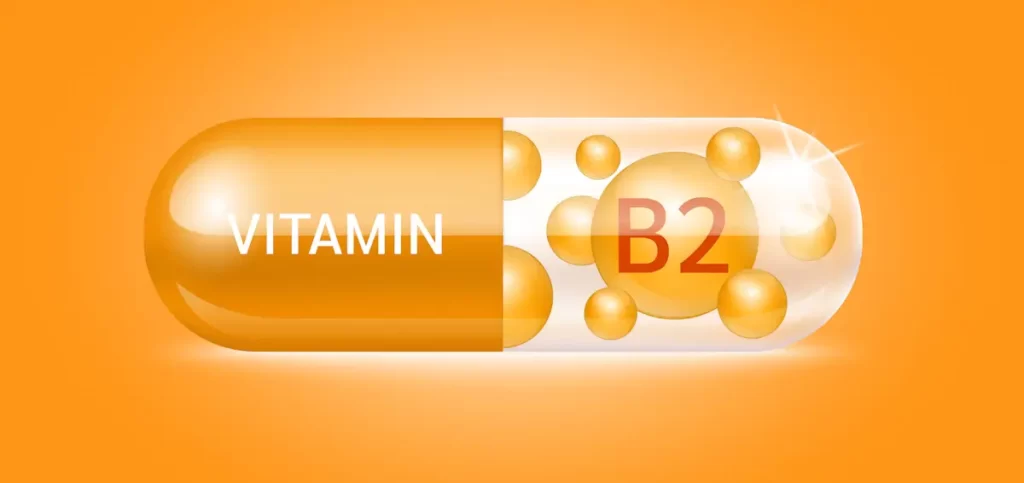Feeling tired or worn out all the time? Vitamin B2, also called riboflavin, plays a key role in turning food into energy for your body. This article will explain how riboflavin supports energy production, its benefits, and where to find it.
Thank you for reading this post, don't forget to subscribe!Keep reading—your health could depend on it!
Key Takeaways
- Riboflavin (Vitamin B2) helps turn food into energy and supports healthy cells, skin, hair, and eyes.
- Key sources include dairy, eggs, green vegetables like spinach, nuts, and organ meats like liver. Cooking methods affect nutrient levels—steaming preserves more riboflavin than boiling.
- Pregnant women need at least 1.4 mg daily for fetal growth; breastfeeding mothers require 1.6 mg to ensure milk production.
- Deficiency symptoms include skin issues, cracked mouth corners (angular stomatitis), sore throat, and fatigue. Vegans and athletes are at higher risk due to dietary or energy demands.
- Supplements range from 25–100 mg doses; excess leaves the body through urine but may cause yellow discoloration as a harmless side effect.
Key Functions of Riboflavin in the Body

Riboflavin helps convert the food you eat into energy. It also plays a big role in keeping your cells healthy and working well.
Energy production from food
The body needs fuel, and Riboflavin (Vitamin B2) helps turn food into energy. It breaks down carbohydrates into glucose, providing power for your cells. Fats and proteins aren’t left out—this vitamin also aids in their metabolism.
“Without Vitamin B2, energy creation slows down, leaving you feeling tired.”
Through its role in flavin mononucleotide (FMN) and flavin adenine dinucleotide (FAD), it supports the enzymes required for these processes. Balanced intake prevents fatigue and keeps your body running smoothly.
Cellular growth, function, and development
Riboflavin plays a key role in cellular function and growth. It helps the body maintain healthy cells by producing energy within them. This process supports tissues like skin, hair, and eyes—keeping them strong and functional.
Cells also rely on riboflavin to grow properly and repair damage.
It assists enzymes like flavin adenine dinucleotide (FAD) in important reactions. These chemical processes impact red blood cell production and DNA repair, which are vital for development.
Riboflavin also protects cells from oxidative stress caused by free radicals, preventing harm to tissues over time.
Dietary Sources of Riboflavin
Riboflavin is found in many foods that are part of a healthy diet. Eating a variety of these can help meet your daily needs.
Food: Dairy, eggs, nuts, green vegetables, meats
Milk and yogurt provide rich, natural sources of vitamin B2. A single cup of milk contains about 0.45 mg of riboflavin, covering a significant portion of the recommended daily allowance (RDA).
Eggs are another reliable option—one large egg offers around 0.23 mg.
Leafy greens like spinach and broccoli pack this nutrient alongside other antioxidants. Nuts such as almonds also offer small amounts while being easy to snack on. Meat, especially organ types like liver, is a powerhouse for riboflavin intake too.
Boiling or frying can reduce levels; steaming or roasting preserves more nutrients.
Cooking habits matter—light exposure and water loss lower riboflavin in meals.
Dietary supplements
Riboflavin is available as standalone supplements or in B-complex vitamins. Common doses include 25 mg, 50 mg, and 100 mg tablets. These supplements work best when taken between meals for better absorption.
Excess riboflavin leaves the body through urine, sometimes causing it to turn yellow or orange.
Long-term use of one B vitamin can upset the balance of others. Multivitamins often include riboflavin along with vitamin B6 and vitamin B12 to avoid disruptions. Always read labels and consult a doctor if unsure about combining dietary sources with supplements.
Riboflavin Deficiency: Signs and Risk Groups
Lack of riboflavin can affect your skin, mouth, and overall health. Certain groups like vegans or pregnant women may face higher risks of deficiency.
Symptoms: Skin disorders, cracks at mouth corners, sore throat
Riboflavin deficiency can cause noticeable symptoms. These issues often impact the skin, mouth, and throat.
- Skin disorders may develop, including redness, dryness, or irritation around the nose and forehead. Some experience itchy rashes as well.
- Cracks at the corners of the mouth are common signs. This condition, called angular stomatitis, can be painful and make it hard to eat or talk.
- A sore throat is another symptom of vitamin B2 deficiency. It might feel swollen or tender and make swallowing uncomfortable.
These symptoms may worsen if riboflavin intake remains low over time. Continue to learn about groups more at risk of this deficiency.
Groups at risk: Vegans, athletes, pregnant women
Some people are more likely to have a riboflavin deficiency. Their diets or life situations may cause low levels of this important vitamin.
- Vegans may lack riboflavin since plant-based diets exclude dairy products, eggs, and meat. Green vegetables and fortified foods can help fill the gap.
- Athletes often need more B vitamins because of high energy demands. Strenuous exercise increases the need for nutrients like riboflavin to support energy production.
- Pregnant women require higher amounts of riboflavin—at least 1.4 mg daily—for fetal growth and development. This amount increases to 1.6 mg during lactation for optimal milk production.
Health Benefits of Adequate Riboflavin Intake
Getting enough riboflavin helps the body heal and stay strong. It supports processes that protect cells from damage and keep them working well.
Prevention of migraine headaches
Riboflavin may help reduce migraine headaches. A study showed that taking 400 mg daily cut migraine attacks by 50%. The Canadian Headache Society also suggests this dosage for prevention.
Riboflavin supports energy production in cells, which could explain its impact on migraines. It’s a safe option with minimal side effects like discolored urine.
Though promising, more studies are needed before making it a standard treatment. Riboflavin supplements or foods like dairy, eggs, and green vegetables can boost intake naturally. Next is its role in cancer prevention….
Potential role in cancer prevention
Some research suggests riboflavin might help lower the risk of certain cancers, like lung and colorectal cancer. A study with 41,514 smokers found current smokers who consumed more riboflavin had a lower chance of developing lung cancer.
This link could be due to its role in protecting DNA from carcinogen damage.
Findings on this topic remain mixed, though. While some evidence supports riboflavin’s protective role against DNA damage and oxidative stress, more studies are needed to confirm these effects.
Next up: understanding Vitamin B3 (Niacin) for health benefits and sources.

Understanding Related B Vitamins: Vitamin B3 (Niacin) – Health Benefits and Sources
Vitamin B3, or niacin, helps turn carbohydrates, fats, and proteins into energy. It supports healthy skin, digestion, and nerve function. A lack of niacin can cause pellagra. Pellagra symptoms include darkened skin patches, diarrhea, and memory problems.
Foods rich in niacin include meats like chicken and turkey. Fish such as salmon is also a good source. Nuts and fortified cereals add to daily intake too. Malnutrition or alcohol use disorder increases the risk of deficiency in this vitamin.
Recommended Intake Levels of Riboflavin
The amount of riboflavin you need depends on your age and life stage. Getting enough daily helps support energy production and overall health.
Daily requirements for different age groups
Getting enough Vitamin B2 (Riboflavin) is crucial to support energy production and overall health. Below is a simple breakdown of the daily intake needs for different age groups:
| Age Group | Daily Requirement (mg/day) |
|---|---|
| Infants (0-6 months) | 0.3 mg |
| Children (4-8 years) | 0.6 mg |
| Boys (14-18 years) | 1.3 mg |
| Pregnant Women | 1.4 mg |
| Breastfeeding Women | 1.6 mg |
Each group has specific needs based on growth, activity levels, or physiological changes. For example, infants require only 0.3 mg daily due to their small size and developing systems. Children aged 4-8 years need slightly more—0.6 mg—to fuel their rapid growth stages.
Teenage boys, during their peak growth phase, have higher requirements of 1.3 mg per day. Pregnancy raises the need to 1.4 mg daily to support the growing baby. Breastfeeding increases it further to 1.6 mg, ensuring adequate milk production for the infant.
Meeting these targets through food or supplements can help sustain optimal energy levels and health.
How to Ensure Sufficient Riboflavin Intake
Eating a mix of riboflavin-rich foods can help your body get what it needs. If diet alone isn’t enough, supplements may be an option to explore.
Combining dietary sources effectively
Mixing different foods boosts riboflavin intake. Eggs, dairy products like milk or yogurt, and fortified cereals are great options. Green vegetables, such as Brussels sprouts, add extra nutrients while supplying riboflavin.
Combining these helps meet the recommended dietary allowance (RDA) without relying on one source.
Cooking methods matter too. Boiling can wash away water-soluble vitamins like vitamin B2. Steaming or microwaving food keeps more nutrients intact. Including these food choices in daily meals ensures better nutrient absorption for energy production and cell growth.
Considerations for supplements
Riboflavin supplements come in multivitamins or as single tablets. Common doses range from 25 mg to 100 mg, making them easy to manage. These are best absorbed between meals for maximum benefit.
Certain medications may lower riboflavin levels in your body. Check with a doctor if you’re on drugs like cisplatin or have health conditions affecting absorption. For vegans or pregnant women lacking dietary sources, supplements can fill the gap.

Precautions and Possible Interactions
Some medications can lower riboflavin levels in your body. Health conditions like liver disorders or chronic alcohol use might also interfere with its absorption.
Interaction with medications
Anticholinergic drugs can block your body from absorbing riboflavin. Tetracycline antibiotics may also cause issues—take them and riboflavin at different times to reduce interference.
Tricyclic antidepressants like amitriptyline can lower riboflavin levels in the blood. Phenothiazines, used for mental health conditions, can do the same. Always let your doctor know about supplements if you’re on these medications.
Conditions that may affect riboflavin levels
Excessive alcohol consumption can lower riboflavin levels. Alcohol interferes with its absorption and speeds up excretion, leading to deficiencies over time. People with chronic conditions such as liver disease or diabetes may also struggle to retain enough riboflavin.
Certain medications, like tetracycline antibiotics, interact with riboflavin supplements. These drugs might reduce the vitamin’s effectiveness or interfere with how the body processes it.
Next up—daily intake recommendations for all age groups!
Conclusion
Vitamin B2 powers your body. It helps turn food into energy and supports healthy skin, eyes, and more. Eating foods like eggs, dairy, and greens ensures you get enough. If needed, supplements can fill in the gaps.
Keep it simple—include riboflavin in your daily diet for overall wellness!
For more insights into the benefits and sources of related nutrients, check out our detailed guide on Vitamin B3 (Niacin) – Health Benefits and Sources.
